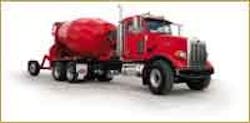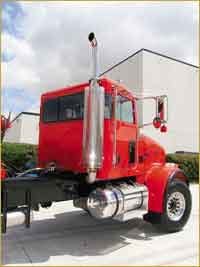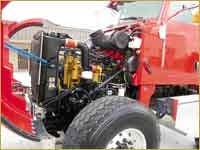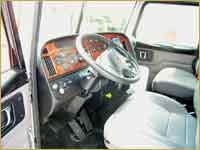Cat C9 with Allison Moves This Pete Well
How much power is enough for a truck? Most drivers always want more than what their bosses buy, which tends to be what's sufficient to do the job and not a lot more. In mixer trucks, especially, power can be marginal if the owner runs a lightweight engine to cut tare weight and boost payload capacity.
That's one reason I drove this Peterbilt 357 mixer chassis near the company's headquarters in Denton, Texas. It had a Caterpillar C9 diesel and Allison HD automatic transmission. Was this "midrange-heavy-duty" engine enough to move a heavily loaded truck in today's fast traffic? The short answer is yes, but please bear with me as I relate a long answer.
It starts in 1977, when I was working near Madison, Wis. On my commute to work, I passed near a ready-mix company's batch plant and, for almost a week of mornings, one of its mixers rudely confronted me. The old, beat-up FWD inevitably emerged from a side road about a half a mile ahead, its driver running the stop sign, turning into my path and then slowly climbing a gentle grade toward an expressway. The truck labored along at 20 to 25 mph with motorists stuck behind it.
The one time I was able to pass, I glanced at the truck and saw the engine through the cut-out opening in its long hood. Judging from its small size, "V" configuration and light-green color, it was a Detroit 6V-53N, all 318 cubic inches of it, screaming away and making maybe 150 horsepower in a truck that probably weighed 55,000 to 60,000 pounds. No wonder the driver runs that stop sign, I thought. He'd never get beyond 10 or 15 mph if he had to start up that hill from a dead stop.
I understood the situation, but was irked that the truck's owner cared more about payload than his pitiful driver and the motoring public. I actually altered the time I left for work to avoid that truck.
These days a typical mixer has an engine with twice the power and displacement. But those 10- and 11-liter Cat and Cummins diesels weigh too much for a ready-mix company based near Riverside, Calif., about an hour from where I now live. It buys a medium-duty Cummins ISC with an Allison automatic; I've seen them on the road and the combination seems to do fine on level pavement, but it can't be too quick on upgrades. That fact actually made it into a recent newspaper article.
The company wanted to build a batch plant in northern San Diego County, but opposition from neighbors caused debate among council members in the affected city. Aside from the usual fears of noise, dust and added traffic, opponents claimed heavy concrete trucks would accelerate too slowly up a nearby freeway ramp and would be a danger to fast-moving traffic.
The company's president tried to prove otherwise by arranging a demonstration. He sent a loaded truck up the ramp while a convoy of cars carrying opponents and supporters of the proposed plant followed, and they later told the newspaper reporter what they saw. Supporters said the truck was doing 45 mph when it began smoothly merging with freeway traffic. But opponents claimed the mixer was doing only 35 mph, and it caused motorists on the freeway to hit their brakes and abruptly change lanes to avoid the truck.
If the truth is somewhere in between—40 mph—that's still 10 to 25 mph slower than the normal flow of traffic on that freeway (except during rush hours). City councilmen indicated they would not approve the application for the plant, so the company's president withdrew it.
Certainly acceleration was not the deciding factor, but that story further illustrates how slow, heavy trucks can irk the public. Should operators be more civic minded—and please drivers, too—by packing more power under the hood?
My seat pants told me that the C9 in this Peterbilt represents a minimum spec for a heavy mixer in today's traffic. Cat rates this model at 350 horsepower and 1,050 lbs.-ft. of torque. These are respectable numbers that sometimes seem larger when channeled through an Allison, because power flow is constant, even during gear changes. The engine just keeps pulling.
The London mixer's barrel was filled to the funnel with crushed rock to simulate 8 yards of concrete, so this truck weighed perhaps 58,000 pounds. On level pavement, the power train briskly pushed the loaded truck to cruising speeds with no work on my part; I just mashed the gas and steered.
To be sure, the engine seemed doggy when moving away from a dead stop until it reached about 1,500 rpm, then seemed to come alive. That's because peak torque is at 1,400—200 rpm higher than with a manual transmission—to better match the Allison's operating characteristics. Otherwise, whenever I wanted power, I stood on the pedal and the engine stayed between 1,600 and 1,900 rpm. When I needed to coast, revs fell way back, just as you'd expect from an automatic.
Climbing freeway ramps, which I did with that recent news-making episode in mind, showed the power train's limits. I watched the speedometer as I reached the top of the short ramps that are prevalent along Interstate 35 in Denton, and saw that the truck was moving at 25 to 40 mph—not real quick—but I always had enough straightaway to accelerate another 5 to 15 mph before having to move into the travel lane.
So "adequate" describes this portion of the performance card, and it's due to the engine's smallish (by today's standards) displacement. Of course, half the time a mixer truck is running empty, and then almost any engine is enough, except maybe that old, screamin' but anemic two-stroke 6V-53N (with the latest upgrades, that little engine now makes as much as 350 horsepower, by the way).
The London body is one of those available in Peterbilt's Integrated Mixer Program. You can order the truck and mixer through the Pete dealer, and it shows up there a few weeks earlier and maybe a few bucks lower in price than if you'd ordered both separately. And the Pete dealer takes care of any warranty claims on the whole shebang. Peterbilt has a similar program for Heil dump bodies.
Drum controls were on a box near the truck's dashboard, as was the selector keypad for the Allison automatic. So everything was convenient and I could watch the drum and everything else through the big rear window or the side-view mirrors. The mirrors are now mounted on the cowl, Kenworth-style, to give a better sight picture through the side windows. This is also supposed to reduce vibration in the mirror glass, but I thought Peterbilt's door-mounted mirrors were pretty steady because the entire cab has always been solid.
The 357 cab is a reinforced version of the one found throughout the "379 family." Though huge guys might think the cab is cramped, most drivers find it plenty roomy for its workaday task. It's made mostly of aluminum to resist corrosion, which is an increasingly serious issue where road departments are using liquid calcium chloride to fight pavement ice. Add in weight savings, and an aluminum cab is an easy thing to sell, salespeople say.
Peterbilt's overall build quality and its many practical features—the 357's easily replaceable fenders, for instance—have allowed it and many of its dealers to successfully pursue the construction market in the last 25 years, so a 357 mixer like this is probably familiar to many readers. This truck was built for California, so who knows, I may see it out here soon.





